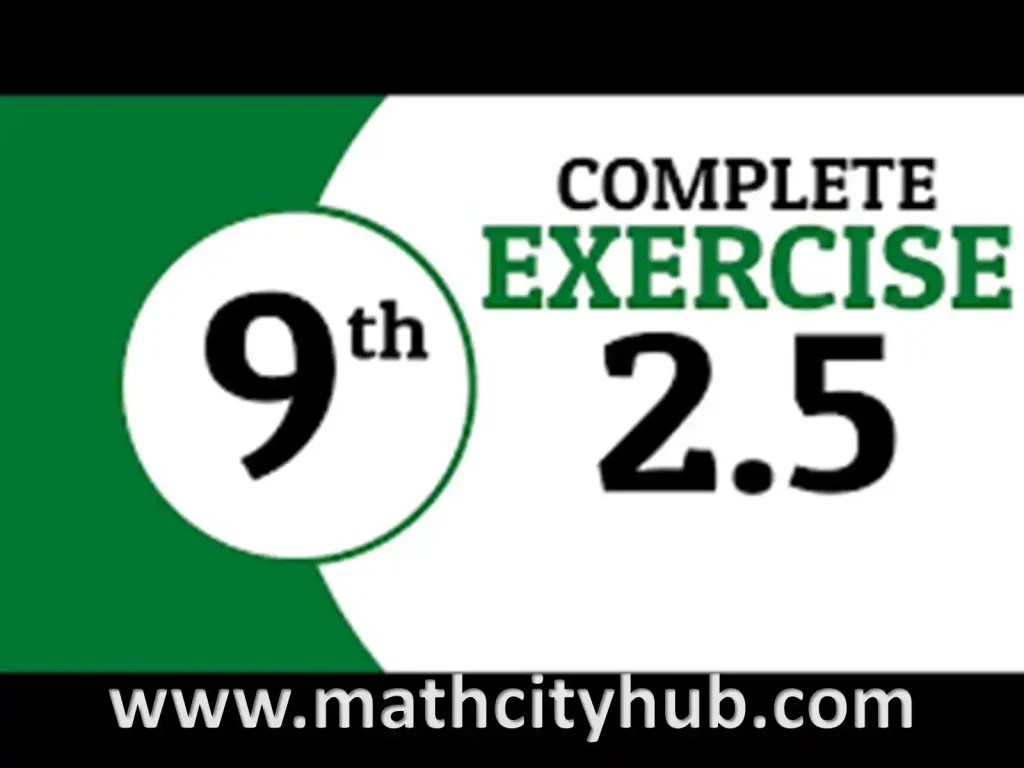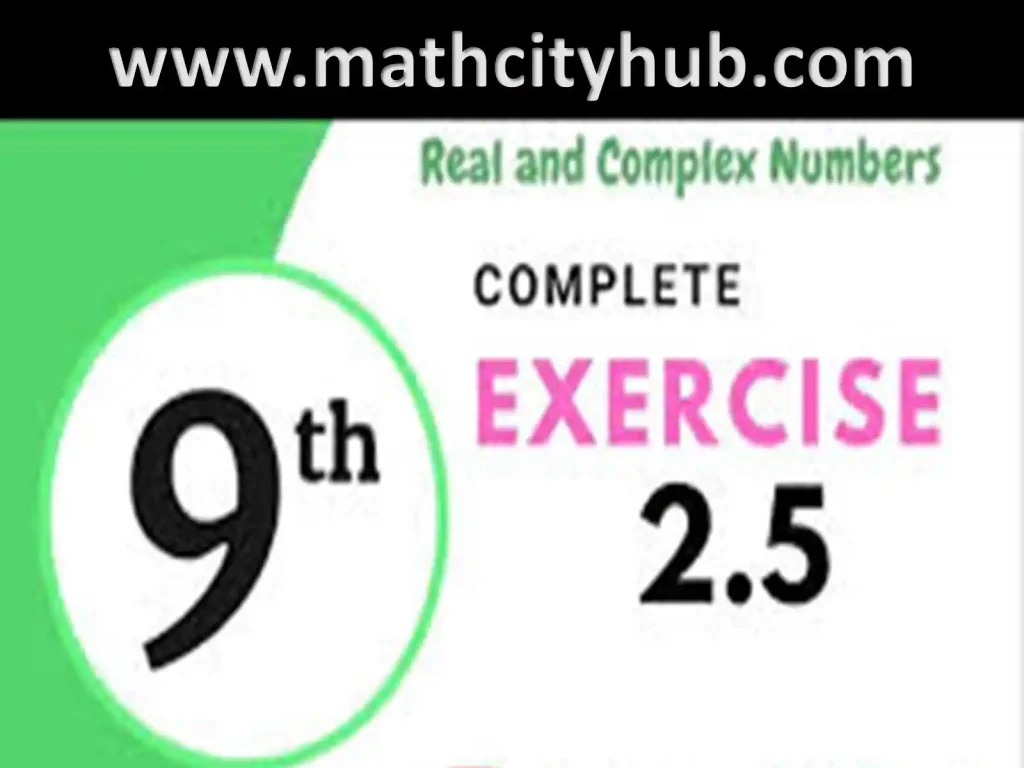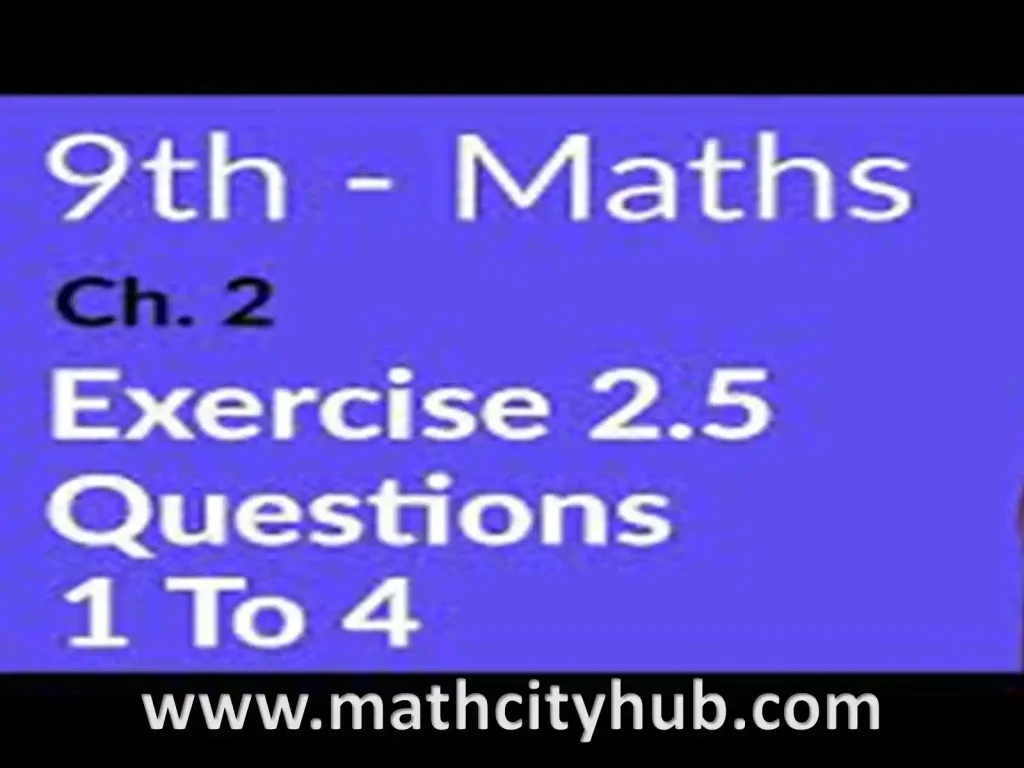Exercise.2.5:A complex number is a number of the form a + bi, where a and b are real numbers, and i is the imaginary unit, which satisfies the equation i^2 = -1.
Complex number plane with real and imaginary axis
The real part of a complex number a + bi is denoted by a, and the imaginary part of a + bi is denoted by b.
Complex numbers can be added, subtracted, multiplied, and divided. They can also be used to represent points on the complex plane, which is a coordinate plane with the real numbers on the horizontal axis and the imaginary numbers on the vertical axis.
Complex numbers are used in many areas of mathematics, including physics, engineering, and computer science. They are also used in some areas of finance, economics, and statistics.
Here are some additional properties of complex numbers:
- The absolute value of a complex number a + bi is |a + bi| = sqrt(a^2 + b^2).
- The conjugate of a complex number a + bi is a – bi.
- The complex number a + bi is equal to 0 if and only if a = 0 and b = 0.
- The complex number a + bi is real if and only if b = 0.
- The complex number a + bi is imaginary if and only if a = 0.
The conjugate of a complex number is another complex number that has the same real part but the opposite imaginary part. In other words, if a complex number is written as z = a + bi, where a and b are real numbers and i is the imaginary unit, then its conjugate is denoted by z̄ and is defined as: Exercise.2.5:
z̄ = a – bi
For example, the conjugate of the complex number 3 + 4i is 3 – 4i, and the conjugate of -2 – 5i is -2 + 5i.
Here are some additional points to note about conjugates:
- The conjugate of a real number is itself.
- Conjugation is an involution, meaning that taking the conjugate of the conjugate of a complex number is the original number.
- Conjugates are useful in various mathematical operations involving complex numbers, such as multiplication and division.
- Conjugates are symmetric with respect to the real axis on the complex plane.
Here are some other ways to represent a conjugate:
- z^*, where the asterisk denotes the conjugation operation.
- z̅, where the bar denotes the conjugation operation (this is also the most common representation). Exercise.2.5:

Introduction for Math
Equality of Complex Numbers and its Properties
Two complex numbers are considered equal if and only if both their real and imaginary parts are equal. In other words, for two complex numbers z1 and z2:
z1 = z2 if and only if Re(z1) = Re(z2) and Im(z1) = Im(z2).
Here, Re(z) and Im(z) denote the real and imaginary parts of the complex number z, respectively.
Properties of Equality of Complex Numbers:
- Reflexive Property: Every complex number is equal to itself.
(z1 = z1) for all complex numbers z1.
- Symmetric Property: If z1 is equal to z2, then z2 is also equal to z1.
(z1 = z2) implies (z2 = z1).
- Transitive Property: If z1 is equal to z2 and z2 is equal to z3, then z1 is also equal to z3.
(z1 = z2) and (z2 = z3) implies (z1 = z3).
- Addition and Subtraction: If z1 = z2 and z3 = z4, then:
a) (z1 + z3) = (z2 + z4) b) (z1 – z3) = (z2 – z4)
- Multiplication and Division: If z1 = z2 and z3 = z4, and z3 ≠ 0 and z4 ≠ 0, then:
a) (z1 * z3) = (z2 * z4) b) (z1 / z3) = (z2 / z4)
Additional Properties:
- The sum and difference of two equal complex numbers are equal. Exercise.2.5:
- The product and quotient of two equal complex numbers are equal.
- The conjugate of a complex number is equal to itself if and only if the number is real.
- The modulus of a complex number is equal to the modulus of its conjugate.
These properties are fundamental to manipulating complex numbers and solving equations involving them.
Complex numbers, often shrouded in mystery, are a powerful extension of the familiar real numbers. These numbers expand our mathematical horizons, allowing us to solve equations previously deemed impossible and unlock new insights into various fields. But what exactly are complex numbers, and why should we care about them?
1. A Journey Beyond the Real:

Real numbers are the basic building blocks of traditional mathematics. They represent quantities on a number line, encompassing positives, negatives, and zero. However, there exist equations with no real solutions, like x^2 + 1 = 0. This is where complex numbers enter the scene.
2. Introducing the Imaginary Unit:
The imaginary unit, denoted by “i,” is the heart of complex numbers. This unit squares to -1, a property that distinguishes it from real numbers. This may seem strange initially, but it unlocks a whole new dimension of mathematical exploration.
3. Form and Structure:
Complex numbers are expressed as a + bi, where “a” and “b” are real numbers and “i” is the imaginary unit. The “a” part represents the real component, while the “bi” part represents the imaginary component. Exercise.2.5:
4. Operations and Properties:
Complex numbers can be added, subtracted, multiplied, and divided, following specific rules that incorporate the unique properties of “i.” They also possess fascinating properties like absolute values, conjugates, and relationships with the complex plane, a visual representation of these numbers.
5. Unlocking the Doors to New Worlds:
Complex numbers are not just mathematical curiosities; they find applications in various fields:
- Physics: Quantum mechanics, electromagnetism, and wave mechanics all rely heavily on complex numbers for calculations and analysis.
- Engineering: Signal processing, control systems, and circuit analysis utilize complex numbers for efficient solutions.
- Computer Science: Complex numbers play a crucial role in cryptography, image processing, and fractal generation. Exercise.2.5:
- Finance and Economics: Complex numbers are employed in quantitative finance and economic modeling for better understanding and risk assessment.
6. A Stepping Stone to Advanced Mathematics:
Complex numbers are not just an isolated concept; they serve as a gateway to further mathematical exploration. They pave the way for understanding complex analysis, analytic number theory, and other sophisticated areas of mathematics.
7. Beyond the Formulas:
While complex numbers possess intricate mathematical properties, their significance transcends technical details. They represent a triumph of human thought, pushing the boundaries of what we thought was possible within the realm of numbers.

Questions & Answers
1. What is a complex number?
A complex number is a number of the form a + bi, where a and b are real numbers, and i is the imaginary unit, which satisfies the equation i^2 = -1.
The real part of a complex number is denoted by a, and the imaginary part is denoted by b.
2. How can complex numbers be added or subtracted?
Complex numbers are added or subtracted by separately adding or subtracting their real and imaginary parts. For example:
(a + bi) + (c + di) = (a + c) + (b + d)i
(a + bi) – (c + di) = (a – c) + (b – d)i
3. How can complex numbers be multiplied or divided?
Multiplying complex numbers involves distributing, using the property i^2 = -1, and combining real and imaginary terms. Dividing complex numbers is typically done by multiplying both numerator and denominator by the denominator’s complex conjugate, which is the same number with a negated imaginary part. Exercise.2.5:
4. What is the absolute value of a complex number?
The absolute value of a complex number z = a + bi is denoted by |z| and is calculated using the formula:
|z| = sqrt(a^2 + b^2)
5. What is the conjugate of a complex number?
The conjugate of a complex number z = a + bi is denoted by z̄ and is obtained by negating the imaginary part:
z̄ = a – bi

6. What is the modulus of a complex number?
The modulus of a complex number is the same as its absolute value.
7. What is the argument of a complex number?
The argument of a complex number z = a + bi is denoted by arg(z) and is the angle between the positive real axis and the line connecting the origin and the point representing z on the complex plane. Exercise.2.5:
8. What are the roots of a complex number?
The roots of a complex number z are the values of x that satisfy the equation z^n = x. For example, the roots of z^2 = 1 are 1 and -1.
9. What are some applications of complex numbers?
Complex numbers are used in various fields, including:
- Physics: Quantum mechanics, electromagnetism, and wave mechanics.
- Engineering: Signal processing, control systems, and circuit analysis.
- Computer Science: Cryptography, image processing, and fractal generation.
- Finance and Economics: Quantitative finance and economic modeling.
Conclusion
Complex numbers are more than just abstract symbols on paper. They are a powerful tool for solving problems, unlocking new areas of knowledge, and pushing the boundaries of human understanding. As we continue to explore their depths, who knows what other fascinating discoveries await us in this realm of the imaginary?
Must Read:
9th-Math-Ch-1-Review: Matrices And Determinants
Exercise.1.6: Solution Of Simultaneous Linear Equations
Exercise.1.5: Multiplicative Inverse a Of Matrices
Exercise.1.4: Multiplication Of Matrices
Exercise.2.2: Properties of Real Numbers
Exercise 1.3: Addition And Subtraction Of Matrices
Exercise.1.2. Types Of Matrices.
Exercise 1.1: Introduction to matrices
Exercise 4.4: Introduction to Algebraic Expressions
Full Book Math 9th Class
Exercise 2.5
Azam Bodla
M.Phil. Mathematics, Content Writer, SEO Expert
Web Developer, Online Tutor
Call or WhatsApp: +923059611600
Gmail:azambodlaa@gmail.com






